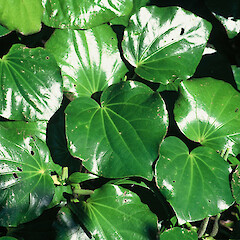Piper excelsum subsp. peltatum
Common name
kawakawa, pepper tree
Synonyms
Macropiper excelsum subsp. peltatum f. peltatum R.O.Gardner
Family
Piperaceae
Flora category
Vascular – Native
Endemic taxon
Yes
Endemic genus
No
Endemic family
No
Structural class
Trees & Shrubs - Dicotyledons
Chromosome number
2n = 26
Current conservation status
The conservation status of all known New Zealand vascular plant taxa at the rank of species and below were reassessed in 2017 using the New Zealand Threat Classification System (NZTCS) – more information about this can be found on the NZTCS website. This report includes a statistical summary and brief notes on changes since 2012 and replaces all previous NZTCS lists for vascular plants.
Please note, threat classifications are often suggested by authors when publications fall between NZTCS assessment periods – an interim threat classification status has not been assessed by the NZTCS panel.
- Conservation status of New Zealand indigenous vascular plants, 2017 . 2018. Peter J. de Lange, Jeremy R. Rolfe, John W. Barkla, Shannel P. Courtney, Paul D. Champion, Leon R. Perrie, Sarah M. Beadel, Kerry A. Ford, Ilse Breitwieser, Ines Schönberger, Rowan Hindmarsh-Walls, Peter B. Heenan and Kate Ladley. Department of Conservation. Source: NZTCS and licensed by DOC for reuse under the Creative Commons Attribution 4.0 International licence.
2017 | At Risk – Naturally Uncommon | Qualifiers: Sp
Previous conservation statuses
2012 | At Risk – Naturally Uncommon
2009 | At Risk – Naturally Uncommon
2004 | Range Restricted
Brief description
Fleshy shrub with jointed green twigs bearing large green glossy heart-shaped thin leaves with hard green flower spikes inhabiting northeastern islands. Leaves to 160mm wide, stalk attached near base of leaf, veins radiating from stalk, slightly peppery to taste. Fruit orange.
Distribution
Endemic. New Zealand: Poor Knights, Mokohinau Islands, Hen (Taranga), Great Barrier (Pitokuku Island), and also from Hauturu (Clark Island) near Whangamata
Habitat
Offshore islands in coastal forest.
Detailed description
Shrub or small tree to at least 3 m tall; stems ± erect (occasionally layering), not notably lenticellate, new shoots green (leaf nerves, petioles and new sterns without reddish colouring), taste oily-aromatic and very peppery; pith of axes (including rachis of spike) usually without a mucilage core (but this sometimes present in sucker shoots), in older (leafless, secondarily thickened) stems the pith not more than 0.5× stem diameter, and remaining intact in the largest trunks. Prophyll a collar to 0.5(-2.0) mm high. Leaf blades submembranous to firmly fleshy ± suborbicular, at vegetative nodes to 100(-160) mm diameter, usually with 7 or 9 principal nerves, cordate at base, with a very narrow or closed sinus, occasionally basal lobes overlapping, or sometimes the blade peltate with the petiole inserted up to 5(-20) mm inside blade margin, upper surface of blade not bullate; petiole to 40(-60) mm long, c.0.4×as long as blade, the sheath 0.3-1.0(-2)× as long as non-sheathing part, truncate-rounded at apex and not produced there, the non-sheathing part of petiole to 3.5 mm diam. Inflorescences solitary or 2-3 together on a short (rarely more than 10 mm long) axillary shoot, and (usually solitary) on the adjacent terminal shoot (occasionally this shoot not fertile); reduced leaf at apex of fertile shoot with a glabrous petiole and usually with a green oblong lamina at least 5 mm long, but lamina often ± lacking, especially on terminal fertile shoot. Female inflorescence erect in flowering and remaining so into fruit, peduncle to c. 1.5 cm long, spike to 60(-100) × c.6 mm diameter, with uniseriate usually 5-10-cellular hairs to 0.15 mm long on lower part of bract stalks and sparingly on rachis, these hairs not obvious on the peduncle just below the lowermost bracts; bracts peltate, bract heads 0.40-0.75 mm diameter; flowers at full emergence centred c.1.3 mm apart, emergent part of ovary ovoid; stigmas 3-4(-5), together c. 1.2 mm diameter. Male inflorescence erect, spike to c.110 mm long, proximally c.6 mm diameter, bracts and hairs as in female inflorescence; staminal filaments c. 0.25 mm long, anthers c.1.00 × 0.75 mm wide. Ripe infructescence c.10 mm diameter; fruitlets coalescent, sunken apically about the persistent dark stigmas, exocarp and mesocarp orange; seed oblong to slightly obovoid, apiculate at apex, c.2.0 × 1.5 dark brown, with (3-)4-5(-7) broad longitudinal furrows.
Similar taxa
Piper excelsum subsp. excelsum from which it differs by its uniformly green, often peltate very peppery tasting leaves. From subsp. peltatum, f. delangei it differs by its less fleshy, more membranous leaves, and less hot, peppery tasting leaves, and more heavily ornamented seeds.
Flowering
September - December
Fruiting
October - August
Propagation technique
Easily grown from cuttings, layered pieces and fresh seed. An attractive shrub or small tree for a shaded site. Cold intolerant.
Threats
Not Threatened. Listed because it is a narrow range offshore island endemic
Etymology
piper: Pepper
excelsum: Tall
peltatum: Shield shape; from the Latin pelta
Taxonomic Notes
The generic distinction between Macropiper and Piper has always been tenuous. Recently Jaramillo et al. (2008) have shown that Macropiper should be merged in Piper. However, they did not effect the full transfer of the New Zealand taxa to Piper. This action was taken by de Lange (2012) for Macropiper excelsum subsp. psittacorum, Macropiper excelsum subsp. peltatum f. peltatum and f. delangei.
Attribution
Fact sheet prepared for NZPCN by P.J. de Lange 30 August 2005. Description based on Gardner (1997).
References and further reading
de Lange, P.J. 2012: Taxonomic notes on the New Zealand flora: new names in Piper (Piperaceae). New Zealand Journal of Botany DOI:10.1080/0028825X.2012.708904
Gardner, R.O. 1997: Macropiper (Piperaceae) in the south-west Pacific. New Zealand Journal of Botany 35: 293-307.
Jaramillo, M.A.; Callejas, R; Davidson, C.; Smith, J.F.; Stevens, A.C.; Tepe, E.J. 2008: A phylogeny of the tropical genus Piper using ITS and the chloroplast intron psbJ-petA. Systematic Botany 33: 647-660.
NZPCN Fact Sheet citation
Please cite as: de Lange, P.J. (Year at time of access): Piper excelsum subsp. peltatum Fact Sheet (content continuously updated). New Zealand Plant Conservation Network. https://www.nzpcn.org.nz/flora/species/piper-excelsum-subsp-peltatum/ (Date website was queried)



